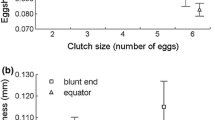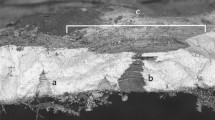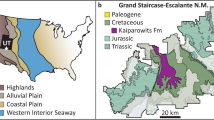Abstract
We describe irregularly calcified egg and eggshell morphologies for the first time in nests of the broad-snouted caiman, Caiman latirostris. Research is based on detailed descriptions of 270 eggs from a total sample of 46,800 collected between 2005 and 2011 in Santa Fe Province, Argentina, and encompasses animals from both natural habitats and held in captivity. We discuss possible reasons for the occurrence of eggs with different mineralisation patterns in our extensive C. latirostris field sample and its conservation significance; the chemistry of egg laying in amniotes is sensitive to environmental contamination which, in turn, has biological implications. Based on our egg sample, we identify two caiman eggshell abnormalities: (1) regularly calcified eggs with either calcitic nodules or superficial wrinkles at one egg end and (2) irregularly calcified eggs with structural gaps that weaken the shell. Some recently laid clutches we examined included eggs with most of the shell broken and detached from the flexible membrane. Most type 1 regularly calcified eggs lost their initial calcified nodules during incubation, suggesting that these deposits do not affect embryo survival rates. In contrast, irregularly calcified caiman eggs have a mean hatching success rate of 8.9 % (range 0–38 %) across our sample compared to a mean normal success of 75 %. Most irregularly calcified caiman eggs probably die because of infections caused by fungi and bacteria in the organic nest material, although another possible explanation that merits further investigation could be an increase in permeability, leading to embryo dehydration.





Similar content being viewed by others
References
Ar A, Rahn H, Paganelli CV (1979) The avian egg: mass and strength. Condor 81:331–337
Asmundson VS (1931) The formation of the hen's egg. Sci Agri 11:1–50
Asmundson VS (1933) The formation of eggs within eggs. Zoolog Anz 104:209–217
Campos Z, Magnusson W, Sanaiotti T, Coutinho M (2008) Reproductive trade-offs in Caiman crocodilus crocodilus and Caiman crocodilus yacare: implications for size-related management quotas. J Herpetol 18:91–96
Deeming DC, Unwin DM (2004) Reptilian incubation: evolution and the fossil record. In: Deeming DC (ed) Reptilian incubation, environment, evolution and behavior. Nottingham University Press, Nottingham, pp 1–14
Erben HK (1970) Ultrastrukturen und mineralisation rezenter und fossiler eischalen bei vögeln und reptilien. Biomineral 1:2–66
Erben HK (1972) Ultrastrukturen und Dicke der Wand pathologische Eischalen. Akad Wissen Lit, Abhand Math Naturwissen Klasse 6:193–216
Erben HK, Hoefs J, Wedepohl KH (1979) Paleobiological and isotopic studies of eggshells from a declining dinosaur species. Paleobiol 5:380–414
Ewert MA, Firth SJ, Nelson CE (1984) Normal and multiple eggshells in batagurine turtles and their implications for dinosaurs and other reptiles. Can J Zool 62:1834–1841
Ferguson MWJ (1981) Extrinsic microbial degradation of the alligator eggshell. Science 214:1135–1137
Ferguson MWJ (1982) The structure and composition of the eggshell and embryonic membranes of Alligator mississippiensis. J Zool 36:99–152
Ferguson MWJ (1985) Reproductive biology and embryology of the crocodilians. In: Gans C, Billett F, Maderson PFA (eds) Biology of the reptilia 14. Wiley, New York, pp 329–491
Fernández MS, Matheos SD (2011) Alteraciones en cáscaras de huevos de dinosaurios en el Cretácico Superior de la provincia de Río Negro, Argentina. Ameghiniana 48:43–52
Grine FE, Kitching JW (1987) Scanning electron microscopy of early dinosaur eggshell structure: a comparison with other rigid sauropsid eggs. Scan Electron Microsc 1:615–630
Hirsch K (2001) Pathological amniote eggshell-fossil and modern. In: Tanke DH, Carpenter K (eds) Mesozoic vertebrate life. Indiana University Press, Bloomington, pp 378–392
Jackson FD, Varricchio DJ (2003) Abnormal, multilayered eggshell in birds: implications for dinosaur reproduction. J Vert Paleontol 23:699–702
Jackson FD, Garrido A, Schmitt JG, Chiappe LM, Dingus L, Loope DB (2004) Abnormal, multilayered titanosaur (Dinosauria: Sauropoda) eggs from in situ clutches at the Auca Mahuevo locality, Neuquén Province, Argentina. J Vertebr Paleontol 24:913–922
Jenkins NJ (1975) Chemical composition of the eggs of the crocodile (Crocodylus novaeguineae). Comp Biochem Phys A 51:891–895
Kellogg ST, Chatterjee DK, Chakrabarty AM (1981) Extrinsic microbial degradation of the alligator eggshell. Science 214:1135–1137
Larriera A (1990) A program of monitoring and recovering of caiman populations in Argentina with the aim of management. In: Crocodiles: proceedings of the 10th working meeting of the IUCN-SSC crocodile specialist group. IUCN, Gland, p1-5
Larriera A (2011) Ranching the broad-snouted caiman (Caiman latirostris) in Argentina: an economic incentive for wetland conservation by local inhabitants In: Abensperg-Traun M, Roe D, O'Criodain C (eds) CITES and CBNRM proceedings of an international symposium “the relevance of CBNRM to the conservation and sustainable use of CITES-listed species in exporting countries”. Vienna, pp 86-92
Larriera A, Imhof A, Siroski P (2008) Estado actual de los programas de conservación y manejo del género Caiman en Argentina 143-179. In: Castroviejo J, Ayarzaguena J, Velasco A (eds) Contribución al conocimiento del Genero Caiman de Suramerica. Publicación Asociación Amigos Doñana, Madrid, pp 1–294
Mikhailov KE, Bray ES, Hirsch KF (1996) Parataxonomy of fossil egg remains (Veterovata): principles and applications. J Vert Paleontol 16:763–769
Packard GC (1991) The physiological and ecological importance of water to embryos of oviparous reptiles. In: Deeming DC, Ferguson MWJ (eds) Egg incubation: its effects on embryonic development in birds and reptiles. Cambridge University Press, Cambridge, pp 213–228
Palmer BD, Guillette LJ Jr (1992) Alligators provide evidence for the evolution of an archosaurian mode of oviparity. Biol Reprod 46:39–47
Paz DA, Yanosky AA, Mercolli C, Pisanó A (1995) Structure of eggshells from two sympatric series of caimans (Caiman latirostris and Caiman yacare) (Crocodylia: Alligatorinae). Anim Behav 4:71–77
Poletta GL, Larriera A, Kleinsorge E, Mudry MD (2009) Genotoxicity of the herbicide formulation Roundup® (glyphosate) in broad-snouted caiman (Caiman latirostris) evidenced by the comet assay and the micronucleus test. Mutat Res Genet Toxicol Environ Mutagen 675:95–102
Romanoff AL, Hutt FB (1945) New data on the origin of double avian eggs. Anat Rec 91:143–154
Romanoff AL, Romanoff AJ (1949) The avian egg. Wiley, New York, 918 pp
Sauveur B, de Reviers M (1992) Capitulo IV Reproducción: incubación. In: Carlos Bauxadé Carbó (ed). Reproducción de las Aves, Madrid, pp 111-125
Schlëich HH, Kastle W (1988) Reptile egg-shells: SEM atlas. Gustav Fischer, Stuttgart, 123 pp
Schmidt WJ (1967) Die Eischalenstruktur eines “ovum in ovo” von Turdus merula. Zool Anz 181:185–190
Thorbjarnarson J (1996) Reproductive characteristics of the order Crocodylia. Herpetologica 52:8–24
Vargas-Albarracin CR (2012) Nutrición. In: Manual de gallinas ponedoras. SENA-CLEM, Chile, pp 14-17
Verdade LM, Larriera A, Piña CI (2010) Broad-snouted caiman Caiman latirostris. In: Manolis SC, Stevenson C (eds) Crocodiles: status survey and conservation action plan, 3rd edn. Crocodile Specialist Group, Darwin, pp 18–22
von Nathusius W (1868) Ûber die Bildung der Schale des Vogeleies. Zeitschrift Natürwissen 31:1921
Webb GJW, Smith AMA (1987) Life history parameters, population dynamics and the management of crocodilians. In: Webb GJW, Manolis C, Whitehead PJ (eds) Wildlife management: crocodiles and alligators. Surrey Beatty and Sons, Sydney, pp 199–210
Weyenbergh (1876) Noticias biológicas y anatómicas sobre el yacaré o Alligator sclerops, pp 244-255.
Wink C, Elsey RM (1994) Morphology of shells from viable and nonviable eggs of the Chinese Alligator (Alligator sinensis). J Morphol 222:103–110
Wink CS, Elsey RM, Bouvier M (1990) Porosity of eggshells from wild and captive, pen-reared alligators (Alligator mississippiensis). J Morphol 203:35–39
Zhao Z, Huang Z (1986) The ultrastructure of the eggshell of the Chinese alligator. Acta Herpetol Sinica 5:129–133
Acknowledgments
This work was supported by the Proyecto Yacaré, Yacarés Santafesinos (Gobierno de la Provincia de Santa Fe/MUPCN) and Programa de Apoyo de Investigación para Estudiantes (CSG/SSC/IUCN) (to M. Simoncini). We thank Frankie Jackson, Leonardo Salgado, Randall Nydam and Jesus Rivas for their comments on earlier drafts of the manuscript and four anonymous reviewers and our editor Sven Thatje for their patience and constructive critiques. Carlos Cotaro (Centro Atomico Bariloche) Miguel Moreno-Azanza and Cristina Gallego (Universidad de Zaragoza) kindly assisted with SEM images, while Nora Ibargüenegoytía and Mauro Cocco connected us with CNEA.
Author information
Authors and Affiliations
Corresponding author
Additional information
Communicated by: Sven Thatje
Electronic supplementary material
Below is the link to the electronic supplementary material.
ESM Table 1
(PDF 71 kb)
Rights and permissions
About this article
Cite this article
Fernández, M.S., Simoncini, M.S. & Dyke, G. Irregularly calcified eggs and eggshells of Caiman latirostris (Alligatoridae: Crocodylia). Naturwissenschaften 100, 451–457 (2013). https://doi.org/10.1007/s00114-013-1044-3
Received:
Revised:
Accepted:
Published:
Issue Date:
DOI: https://doi.org/10.1007/s00114-013-1044-3




